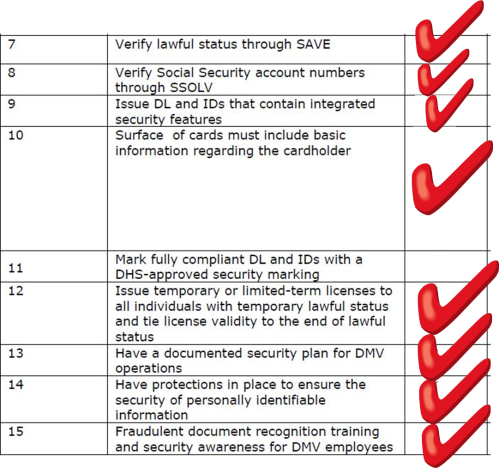Kaye Beach
September 14, 2012
Have you noticed the flurry of activity related to Oklahoma’s driver’s licenses? Did your Real ID radar begin to ping?
A Google photo search for “new driver’s license design” shows that many states, like Oklahoma, are getting new driver’s license designs. And like Oklahoma, the photos are all moved to the left. This isn’t a DMV fad. These standards come from somewhere. — 2012 AAMVA North American Standard – DL/ID Card Design
“AAMVA (the American Association of Motor Vehicle Administrators) is called the “backbone” and hub” of the Real ID Act in the final rules issued by DHS” Mark Lerner, testimony before the Michigan House of Representatives, 2008
Several news items were released last week about some changes coming to Oklahoma’s driver’s licenses.
Oklahoma Rolls Out New Driver License and Upgraded Issuance System by MorphoTrust Sep 06, 2012 by Business Wire
“The new license meets rigorous security requirements and will not only upgrade our system but enhance customer service as well,” said Michael C. Thompson, Commissioner for the Oklahoma Department of Public Safety.
Oklahoma driver’s license will get makeover
Repositioned photograph is among changes to be rolled out over next several months for Oklahoma driver’s license
“They totally redesigned the system to where it’s going to be faster for the operator, which will speed up the line of people waiting at the tag agencies and exam offices.”
These news items were primed by many articles released over the last couple of months regarding the horrendous waits driver’s license applicants are forced to undergo in our state since ‘The number of examiners at licensing offices statewide decreased from 152 in 2009 to 105 this year. The number of testing sites has been reduced from 89 to 36 in a decade’
Long lines drive push to help Oklahoma driver’s license exam sites
At this point, Oklahomans are frustrated and the news of any changes that could help speed up the process are sure to be greeted with a huge sigh of relief and little scrutiny.
A little scrutiny is in order.
The deadline for meeting the standards of the REAL ID Act is January 15, 2013.
The Real ID Act passed in 2005 imposed federal guidelines that use INTERNATIONAL standards for state driver’s licenses and ID documents
REAL ID licenses are to be
(including facial biometrics)
This and other information is to be shared
There are 18 initial benchmarks (39 benchmarks total) to the Real ID Act of 2005 that, once they are achieved, a state can consider to be in “material compliance” with the Act. A state is in “full compliance” with the Real ID Act upon meeting all 39 of the benchmarks.
Once material compliance is achieved a state may request to be able to place a gold star on their state license to indicate that the card is acceptable for “federal identification purposes” from the DHS.
Spring of this year seven states were named as being the naughty foot draggers regarding meeting the 18 Real ID benchmarks. Oklahoma is listed as one of those laggard seven states and for good reason-our state passed a law prohibiting implementation of the federal Real ID Act in 2008.
Oklahoma – OKLA. STAT. ANN, tit. 47, § 6-110.3 (2007) (The State of Oklahoma shall not participate in the implementation of the REAL ID Act of 2005. The Department of Public Safety is hereby directed not to implement the provisions of the REAL ID Act of 2005 and to report to the Governor and the Legislature any attempt by agencies or agents of the United States Department of Homeland Security to secure the implementation of the REAL ID Act of 2005 through the operations of that or any other state department. . .
The President of the Coalition for a Secure Driver’s License took it upon himself to help the Department of Homeland Security pressure and threaten these last remaining rebel states:
“It’s their last opportunity to get on board with the REAL ID rules or face consequences. . . . REAL ID is no longer a policy matter, the REAL ID debate is over. REAL ID is now part of DHS’ ongoing operations.”
PR Newswire (http://s.tt/1bIrU)
What are the “consequences” of not having a Real ID? Here is what we are told;
“In the future, only those state issued Driver Licenses and Identification cards which are fully compliant with the REAL ID act of 2005 will be authorized for use as identification for official federal government purposes, such as boarding commercial aircraft and entering certain regulated federal facilities.” Alabama DMV-STAR ID
Does this mean we won’t be able to fly? In a word-no. We will still be able to fly. A passport will work as well as a military ID. Of course any government issued photo ID means biometrics and carries with it the some of the same concerns as Real ID. Any lesser ID may require secondary screening procedures, but you can fly without a Real ID. As far as the federal buildings. That will be interesting. Barring US citizens from certain federal building will probably set off a constitutional showdown.
Oklahoma was not alone in their opposition to the Real ID Act. At least 25 states passed a law or resolution prohibiting the implementation of Real ID in their states. This was a historic level of rebellion and one that both red and blue states participated.
At least 13 (the National Conference of State Legislatures recognizes 16) states passed an actual law against Real ID but we know from Congressional documents that some of these states are quietly issuing Real ID compliant driver’s licenses anyways.
Thirteen states have laws prohibiting compliance with the REAL ID Act. Even so, DHS believes that some of these states already issue secure identification documents consistent with the standards of the regulation. Link
These states may not sign up for the gold star just yet, but with a wink and a nod, they are just as surely undermining the will of the people by meeting the first 18 benchmarks of Real ID. To state it simply, these states are positioned to do the bidding of the Department of Homeland Security by meeting the requirements of the Real ID Act while retaining plausible deniability about violating their states’ law that prohibits implementation of the Real ID Act.
At least nineteen states are now in compliance with the Act. Twenty-six more are reported to have committed to meet the standards before the (new) deadline. (Dec. 1, 2014) link
So where does Oklahoma stand on the 18 (Real ID) benchmarks?
I will show you that Oklahoma is merely one benchmark away from compliance with this international ID scheme that caused an unprecedented uproar by the states following its introduction in 2005.
Oklahoma has progressed from meeting 9 of these benchmarks in 2008 to currently meeting 14 of the 18 Real ID benchmarks. (3 of the benchmarks pertain to formalizing commitment by the state to REAL ID. State’s that have passed a law prohibiting Real ID implementation are forgiven these benchmarks by the Dept. of Homeland Security. That is the “wink and a nod” Do in reality, Oklahoma is really only one benchmark away from being considered Real ID compliant.)
Doesn’t appear that the law prohibiting implementation of the provisions of Real ID slowed us down much, does it?
Some of these 18 benchmarks are sensible measures that many states were already working on prior to Real ID anyways.
However, benchmark Number 1 is a REAL problem!
Benchmark #1. “Mandatory facial image capture and retention of such image.”
Let me explain briefly why: the digital facial photo is a biometric suitable for use with facial recognition software. In fact, facial biometrics is the governments biometric of choice. Why? It is not the most accurate biometric for identification purposes but it does allow us to be identified in public without our knowledge or consent. Never mind that we have the right to go about our business, as long as we are not a criminal or suspect, without be investigated. The Supreme Court has upheld our right to anonymity on several occasions in recent history.
Here is just one example;
Anonymity is a shield from the tyranny of the majority … It thus exemplifies the purpose behind the Bill of Rights, and of the First Amendment in particular: to protect unpopular individuals from retaliation–and their ideas from suppression–at the hand of an intolerant society.”
McIntyre v. Ohio Elections Comm’n, 514 U.S. 334
The inaccuracy of facial recognition could cause anyone to be misidentified which would introduce the unfortunate person host of unpleasant possibilities. But, I suppose, it is ‘good enough for government work,’ as they say. But it gets even worse.
After the initial 18 benchmarks are met, the states will proceed to implement the next 21 benchmarks, step by step enrolling us into a global biometric identity system.
“The main ideology for defining the design of the DL/ID is the minimum acceptable set of requirements to guarantee global interoperability. “
Source: Personal Identification – AAMVA North American Standard – DL/ID Card Design, 2012
Myself as well as many other policy watchers that care to know, have been warning for years that our government intends to use those DL photos, conveniently combined with our personal, biographical information to not just identify us in public absent of any specific, articulable suspicion; they intend to use our facial biometrics to investigate and even predict based on the associated data- whether we are more or less likely to present a threat to government. As of late, these intentions have been loosed from obscure, seldom read government documents and have been printed in black and white for the world to see.
In addition to scanning mugshots for a match, FBI officials have indicated that they are keen to track a suspect by picking out their face in a crowd.
Another application would be the reverse: images of a person of interest from security cameras or public photos uploaded onto the internet could be compared against a national repository of images held by the FBI. An algorithm would perform an automatic search and return a list of potential hits for an officer to sort through and use as possible leads for an investigation.
New Scientist, September 7, 2012 FBI launches $1 billion face recognition project
And then this-a first-law enforcement admits to using facial recognition on protestors in public.
Computer World: Undercover cops secretly use smartphones, face recognition to spy on crowds
And this one from June 16, 2013, the Washington Post:
State photo-ID databases become troves for police
Oklahoma residents who prefer to not be enrolled into this biometric identification system ought to be asking their representatives why the state is continuing in the fulfillment of the Real ID Act in spite of the law which clearly expresses the will of the people to not participate in the international biometric identity scheme.












